
by Carrie Stevenson | Oct 3, 2025
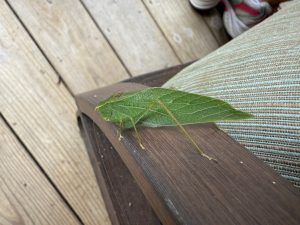
A typical katydid, with remarkable leaf-like camouflage. Photo credit: Carrie Stevenson, UF IFAS Extension
The intricate camouflage developed within the animal kingdom never fails to fascinate me. From fish that look like seagrass blades to butterflies that look like tree bark—or a pair of eyes—the variety, color, and textures are just mind-boggling. Among those are the leaf bugs, or katydids, that flawlessly evoke natural foliage. I had one join me on a patio chair recently, and I couldn’t stop starting at the detailed venation on their wings, which perfectly mimicked the veins on a leaf.
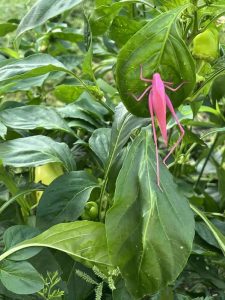
One of the pink katydids on display at the Audubon Insectarium. Photo credit: Amy Pitre courtesy LSU AgCenter
There are well over 6,000 species of katydids, and they’re found on every continent but Antarctica. Related to crickets and grasshoppers, they are similar in that they are remarkable jumpers, with strong hind legs that can also produce recognizable scraping, buzzing, and trilling sounds. The insects got their name from the perception that the noises they produce sound like, “Katy did!, Katy didn’t!” which are primarily made by males of the species. Song production and recognition among katydids are highly developed, used for warnings, attracting mates, or defending territory. Katydids detect sounds by raising their front legs, which have sensing/hearing patches called tympanum. Katydid and cicada songs can be differentiated by timing—cicadas trill during the day, while katydids are active at night.
Katydids have antennae nearly as long as their bodies, and despite their large wings are not strong flyers. Every katydid I’ve ever seen is a leafy green color, blending perfectly into its surroundings and hiding in plain sight from avian predators. However, they come in several different colors, including tan, yellow, orange, and hot pink. I cannot fathom how hot pink is an effective adaptation, but they are occasionally found—at a rate of 1 in 500—in the wild. The pink coloration is due to a genetic condition called erythrism, which is similar to the recessive traits causing albinism. New Orleans’ Audubon Insectarium exhibits several pink katydids, which, with no natural predators, can live typical katydid lifespans.
Katydids are found widely in the state and can be a pest of citrus, but are not considered a major issue. In a home garden, they are generally considered beneficial. While they might nibble on plant parts, they also feed on pest insects like aphids and can aid in pollination.
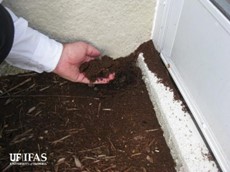
by Donna Arnold | Sep 25, 2025
When the Ground Moves.
It started with a quiet day, and a curious bag of sand brought into the extension office but inside was more than just sand. It was crawling with tawny crazy ants (Nylanderia fulva), one of Florida’s fastest-spreading invasive pests. Known for their erratic movement and massive colonies that can make the ground seem alive, these reddish-brown ants are now a growing concern for gardeners across some Florida counties. Unlike fire ants, tawny crazy ants don’t sting, but they can nip with their chewing mouthparts. Their sheer numbers can overwhelm outdoor spaces, crawling on people and spoiling the enjoyment of patios, gardens, and recreational areas. They nest in moist, protected areas such as leaf litter, potted plants, and under debris, often forming sprawling colonies with multiple queens.
Beyond being a nuisance, these ants pose serious risks. They’ve been known to cause electrical shortages by infiltrating equipment, sometimes leading to costly damage. In some Caribbean islands, they’ve harmed organic crops, and in Colombia, infestations have even led to the death of small animals due to asphyxiation. Larger animals have been attacked around sensitive areas like the eyes and hooves. Tawny crazy ants also disrupt local ecosystems. Their aggressive spread displaces native ant species and reduces biodiversity. While Florida hasn’t reported agricultural damage yet, the potential remains, especially in organic farming systems.

Identification Tips
Workers are small (less than 1/8 inch), monomorphic, and covered in fine hairs that give them a matte appearance. They have one petiole segment and 12 antennal segments, including a long first segment called the scape. Colonies don’t form mounds but may tunnel in sandy soil. Queens are often found among workers, especially in warmer months. If you suspect an infestation, contact your local UF/IFAS Extension office.

Management Challenges
Controlling tawny crazy ants is notoriously difficult. Spraying alone is ineffective, and most insecticides only work for a few days before ants’ return. Integrated Pest Management (IPM) is the recommended approach. IPM combines multiple tactics, starting with accurate identification and monitoring, followed by strategic product application and habitat modification. Professional pest control services that specialize in IPM are often necessary. Timing is critical, and overuse of products is not only ineffective but may violate legal limits. Keep records of infestation locations to anticipate reinvasion, which typically occurs annually. While complete eradication is unlikely in established areas, population suppression is achievable. Interestingly, research suggests that within about a decade, populations may naturally decline, allowing native species to rebound.
Tawny crazy ants are more than just a backyard annoyance they are a complex ecological and household threat. Awareness, early identification, and professional management are key to minimizing their impact. As these ants continue to spread, staying informed and proactive will help protect your property and Florida’s delicate ecosystems.
For more information call or visit your local extension office or follow the link below.
https://edis.ifas.ufl.edu/publication/IN1076
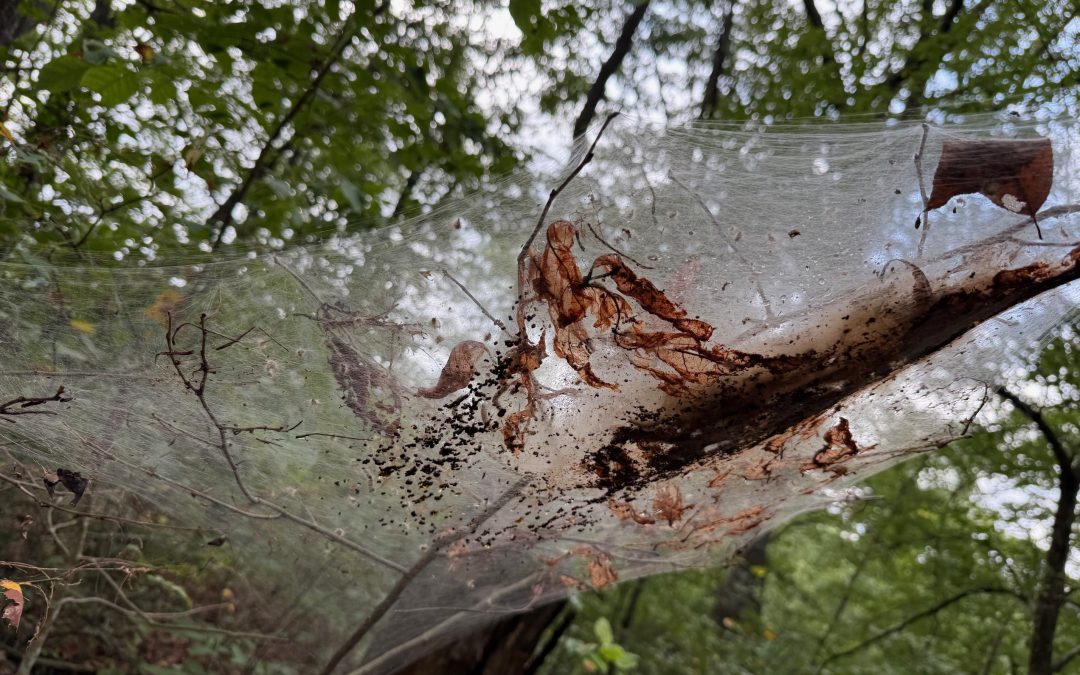
by Carrie Stevenson | Sep 11, 2025
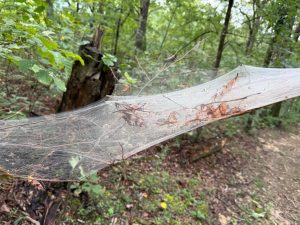
Fall webworms in a Tennessee forest. Photo credit: UF IFAS Extension
Have you ever noticed the big knots of webbing in some trees this time of year? They’re usually sort of a brown-pink hue, much too big for a spider but not really tightly wound enough to be a nest or cocoon.
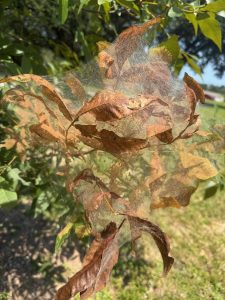
A close-up of the fall webworm tent reveals dozens of tiny caterpillars and skeletonized leaves. Photo credit: Carrie Stevenson, UF IFAS Extension
What you’re seeing actually is a cocoon of sorts—a big shared one created by hundreds of larval fall webworms (Hyphantria cunea). This common name is a bit of a misnomer. The webbing—often referred to as a tent—is built in late summer, not fall, and these are caterpillars, not worms. But I suppose it gets the idea across!
On a recent hike, I saw webbing up close, so I was able to really investigate the caterpillars inside. They are quite small, and will undergo up to five molting stages, or instars, before adulthood. Upon transformation, they will become white or speckled moths. Fall webworms are native to the entirety of the United States—in the northern end of their range the moths will be solid white, whereas further south they will have darker spots on their wings. Due to accidental introduction, fall webworms are invasive throughout Europe and portions of Asia.
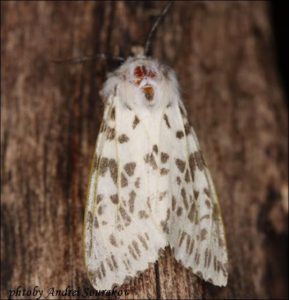
Adult fall webworm, with spots on white, which is typical for members of this species from the southern part of its range. Photo credit: Lyle Buss, UF
Host plants include a wide range of more than 80 deciduous hardwood species, allowing a broader spectrum of places for the caterpillars to undergo their various larval phases. During their months in the “tent”, the larvae feed on and skeletonize the leaves encapsulated within their webbing. This causes damage to the leaves, but results in no permanent issues to the trees—being late summer and fall during their tenure, the trees eventually lose their leaves anyway.
While the tents are a bit unsightly, controlling the caterpillars or removing the webs is unnecessary. Once they’ve reached their final caterpillar stage, they’ll hide out in tree bark and leaf litter on the ground until metamorphosizing into moths the following spring. Adult moths mate and lay eggs in the late spring and summer, starting the cycle all over again.
by Carrie Stevenson | Aug 9, 2025
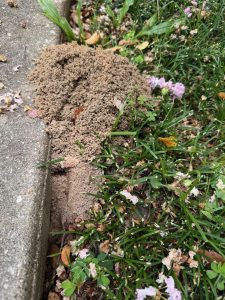
A cicada killer burrow at the Escambia County Extension Office. Photo credit: Carrie Stevenson, UF IFAS Extension
The other day, our Horticulture agent, Beth Bolles, called me over to point out something of interest. Along the sidewalk between our buildings was a sandy burrow that looked like a cross between a fire ant mound and a crawfish burrow. “People ask me about these all the time—you may want to write about them,” she said. Sure enough, just a couple days later I was tagged in a Facebook photo asking if I knew what this weird sandy mound was.
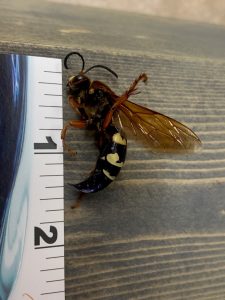
An up-close photo of a cicada killer brought into our office for identification. Photo credit: Beth Bolles, UF IFAS Extension
What Beth pointed out was the burrow of a cicada killer (Sphecius speciosus) wasp, also called the great ground hornet. Cicada killers are large (among the largest in the country, at 1.5-2” long) ground-dwelling wasps that use cicadas for an important part of their life cycle. They can fly, but I have observed them crawling through low weeds and grass. They have black bodies and wings with brilliant yellow stripes on their abdomens, and adults feed on flower nectar.
These wasps’ reproductive cycle is rather fascinating. After males and females emerge from the soil in the summer, they mate while in flight. Females then dig the burrows, using their front legs to scrape soil out of the ground and kick it out with their hind legs. Burrows may be up to 4 feet deep, with branches and larger cells.

A female cicada killer with her cicada prey. Photo credit: North Carolina State University Extension
Future moms then seek out cicadas, which they sting and paralyze on the leg. The wasps drag cicadas on their backs and into their underground burrows. They place 1-4 cicadas in each cell, depending on insect size. Once this task is completed, the females lay eggs—one into each cicada body. The sex of their offspring can be determined by placement, with the more substantial cicadas implanted with future females, who will need the extra energy. Female cicada killers have been observed to share their burrows with as many as 3 other wasps.
While female wasps stay busy with reproduction and burrowing, the males primarily serve roles of protection and competition for mates. Male cicada killers are known to “invade personal space” of humans by hovering at eye level, and can seem aggressive. However, they are harmless—only the females have stingers!

by Evan Anderson | Jul 27, 2025
The warm Florida climate makes it a biologically diverse place, with plants and animals from all over the world finding a foothold here. Some are benign, while others can become pests that harm the environment or get in the way of human activities. One such pest is the red imported fire ant, a visitor from South America. Introduced to North America somewhere in the 1930s or 1940s, these ants are native to a region of savannas and wetlands, where the rainy season brings flooding part of the year. Finding a similar climate along the Gulf coast after hitching a ride on ships, what these ants did NOT find were predators that could keep their populations in check. They have since spread throughout the southeast, and are predicted to make their way up the east coast as far as Maryland, west into Texas before it becomes too dry for them to live comfortably, and even along the Pacific coast of the United States.
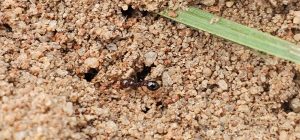
A red imported fire ant.
Though they are called ‘red’, their coloration is often reddish-brown with a darker abdomen. Populations in different areas may vary in their particular shade of color. They range in size from 1/8 to ¼ inch in length. A characteristic identifier for this species of ant is their mounds. These are not just regular anthills, where workers digging tunnels belowground dump grains of soil in a pile. Fire ant mounds help the colony regulate temperatures and moisture levels. They are often constructed in open, sunny locations. Disturbing a mound will cause the ants within it to swarm, with hundreds of ants suddenly ready to sting anything around. Their sting usually leaves a white pustule on the skin, coupled with an intense burning or itching sensation. Being attacked by fire ants is one of the least fun things you can do in a garden or landscape.
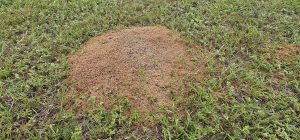
A fire ant mound.
How do we get rid of fire ants? It is important to understand that fire ants don’t live alone. They are dependent on their colony, where workers forage for food, soldiers protect the nest, and the queen (or queens – fire ant nests have been known to have multiple queens) lays eggs. The queen remains sheltered inside the nest, and until she is gone, the nest can replace its workers. Therefore, any treatment must effectively remove the queen.
Home remedies are often ineffective. Pouring boiling water over ant mounds can damage the colony, but may not reach deep enough into the mound to kill the queen. Applying dry grits to a mound will not harm the ants. Other remedies, such as club soda, simply do not work, and while gasoline and other harsh chemicals might kill some ants, they are not guaranteed to kill the queen. They are likely to cause contamination of the groundwater, however.
What are effective are insecticides, formulated as baits or mound drenches or treatments. Baits are taken by the workers back into the nest, where they are fed to the queen. Mound treatments, when properly applied, soak into the mound and are able to penetrate deeply enough to eliminate the colony. Read the label of any product you choose carefully and follow the instructions.
For more information, see our EDIS fact sheet here:
ENY226/LH059: Managing Imported Fire Ants in Urban Areas
Evan Anderson
Walton County Horticulture Agent
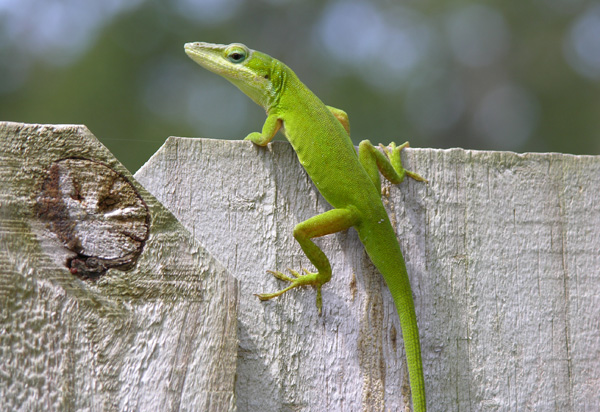
by Carrie Stevenson | Jul 11, 2025
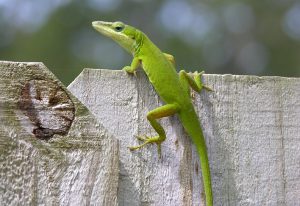
Green anole on a fence post. Photo credit: Dr. Steve A. Johnson, UF
There’s plenty of animals you might call “cute”, but lizards usually aren’t among them. However, I’d take exception to that premise when discussing the green anole (Anolis carolinensis). With big blue eyes, brilliant green skin, and flirty males doing push-ups and flexing their dewlaps (the pink throat fan) at you, these little reptiles are more endearing than most.
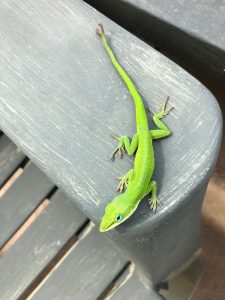
A green anole–with a slightly forked tail–poses on a deck chair. Photo credit: Carrie Stevenson, UF IFAS Extension
Native to Florida and the deep South, they are competent crawlers, prowlers, and predators. I see them frequently on my office building’s outer stucco walls, running along fences, or skittering up trees. They feed on beetles, termites, ants, worms, spiders, and more. Called the “American chameleon” by some, they possess excellent camouflage, changing their skin rapidly from green to dull brown depending on their backgrounds.
Over the last few years, I—and many biologists—have been concerned about the health of their population. As the invasive Cuban brown anole successfully gained a foothold in north Florida, I saw fewer green anoles and many more of the browns. It has seemed that the greens were losing ground. The invasive species can outcompete the native by eating the green anoles’ young and eggs.
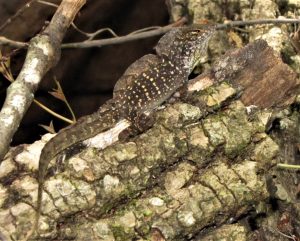
Male brown anole on a tree. Photo credit: Dr. Steve A. Johnson, UF
A recent study by a UF PhD candidate found another explanation for why Floridians have seen more brown anoles than green. His study found that the two species have found a way to coexist—the green anoles are moving further up the canopy (an average of 17x higher!), while browns are staying closer to ground level. The green anoles thrive in more natural areas, whereas the brown anoles do well in lower level urban surroundings.
Interestingly, this summer I’ve noticed a resurgence in green anoles and have rarely seen brown ones. I am wondering if our snow days knocked the tropical brown anole populations back, enabling the more temperate greens to recover. Time will tell if the greens have regained their advantage or if it’s only temporary.
One of the best ways to help improve green anole populations is to plant more native vegetation, especially multiple layers, to create a varied canopy. For more information on how to do that, check out our Florida-Friendly Landscaping Guide to Plant Selection and Landscape Design.



















